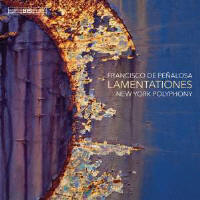Texte paru dans: / Appeared in: |
|
|
Outil de traduction ~ (Très approximatif) |
|
|
Reviewer: Peter
Loewen
Thoughts of Spanish
Renaissance music drift to the Siglo de Oro—the 16th Century that yielded
works by Morales, Lobo, Victoria, Guerrero. The list goes on and on.
Thinking back to the great music of the Spanish 15th Century,
though, puts one in mind of the great cancioneros, especially the Cancionero
de Palacio, a monument associated with Catholic Monarchs Ferdinand and
Isabella. But the composers who contributed villancicos and romanzas to this
remarkable collection of secular music were also composers of sacred music.
This excellent recording by New York Polyphony makes that eminently clear.
In fact, one might argue that without the flourishing of polyphony in late
15th-Century Spain, there might not have been a Siglo de Oro. The program by New York Polyphonyconcentrates on the Latin vocal music of Francisco de Peñalosa (1470-1528) but also includes works by his contemporary Pedro de Escobar (c. 1465-after 1535), and Francisco Guerrero (1528-99). Both the music and performances are quite exceptional. The major compositions are the Lamentations of Jeremiah for Wednesday and Thursday of Holy Week. Peñalosa’s style of polyphony is similar to Josquin’s—lucid passages of imitation broken up by chordal homophony. The Spanish composer deviates from the French polyphonist only in the extent of his dependence on dissonance to intensify the meaning of text. This is clear in the Lamentationes Jeremiae Feria V at the first statement of “lamentationem”. Even the Hebrew letters that mark scriptural passages (Aleph, Beth, and Ghimel) get special treatment with an extra helping of suspensions and parallel perfect intervals. The same effect obtains in the “Alleluia” of his motet ‘Unica Est Columba Mea’ from the Song of Songs (6:9). There are too many other wonderful moments on the recording to list here. Three movements from Peñalosa’s Homme Armé Mass show that he had a grasp of all of the contrapuntal methods then in vogue. In the ‘Angus Dei’ the secular song appears like a cantus firmus in the upper voice part; in the ‘Credo’ it appears as a parody, where the cantus firmus is broken into points of imitation. Another lovely piece is Guerrero’s ‘Antes Que Comais a Dios’. It comes from a collection of villancicos a lo divino—a vernacular song but with religious text. It sounds every bit like a contemporary Italian madrigal. Texts and notes are in English. | |
|
|
|
|
Cliquez l'un ou l'autre
bouton pour découvrir bien d'autres critiques de CD |
|




